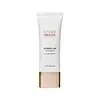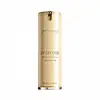What's inside
What's inside
 Key Ingredients
Key Ingredients

 Benefits
Benefits

 Concerns
Concerns

 Ingredients Side-by-side
Ingredients Side-by-side

C9-15 Alkyl Phosphate
CleansingC20-22 Alcohols
Emulsion StabilisingSilica
AbrasiveCaprylyl Methicone
Skin ConditioningCurcuma Longa Root Water
MaskingEthylhexyl Methoxycinnamate
UV AbsorberEthylhexyl Salicylate
UV AbsorberButylene Glycol
HumectantC12-15 Alkyl Benzoate
AntimicrobialDiethylamino Hydroxybenzoyl Hexyl Benzoate
UV FilterHomosalate
Skin ConditioningOctocrylene
UV AbsorberTitanium Dioxide
Cosmetic Colorant1,2-Hexanediol
Skin ConditioningNiacinamide
SmoothingAlcohol
AntimicrobialHylocereus Undatus Fruit Extract
Skin ConditioningSalvia Hispanica Seed Extract
EmollientPortulaca Oleracea Extract
Skin ConditioningCentella Asiatica Extract
CleansingHouttuynia Cordata Extract
Skin ConditioningPichia Ferment Lysate Filtrate
HumectantCamellia Sinensis Leaf Water
MaskingDiospyros Kaki Leaf Extract
Skin ProtectingEchium Plantagineum Seed Oil
Skin ConditioningCardiospermum Halicacabum Flower/Leaf/Vine Extract
Skin ConditioningHelianthus Annuus Seed Oil Unsaponifiables
EmollientGlyceryl Stearate
EmollientBehenyl Alcohol
EmollientAluminum Stearate
Cosmetic ColorantPolyhydroxystearic Acid
EmulsifyingSodium Acrylate/Sodium Acryloyldimethyl Taurate Copolymer
Emulsion StabilisingTromethamine
BufferingIsohexadecane
EmollientPolysorbate 80
EmulsifyingPropanediol
SolventSaccharide Hydrolysate
HumectantPolyacrylate Crosspolymer-6
Emulsion StabilisingAlumina
AbrasiveEthylhexylglycerin
Skin ConditioningGlyceryl Caprylate
EmollientOctyldodecanol
EmollientXanthan Gum
EmulsifyingAdenosine
Skin ConditioningGlycerin
HumectantHydrogenated Lecithin
EmulsifyingRaffinose
Skin ConditioningPentylene Glycol
Skin ConditioningPanthenol
Skin ConditioningCholesterol
EmollientHydrolyzed Lupine Protein
Skin ConditioningCeramide NP
Skin ConditioningLactic Acid/Glycolic Acid Copolymer
Skin ConditioningPolyvinyl Alcohol
Glycine
BufferingGlutamic Acid
HumectantGlutamine
Skin ConditioningLysine
Skin ConditioningLeucine
Skin ConditioningValine
MaskingSerine
MaskingAspartic Acid
MaskingAlanine
MaskingArginine
MaskingIsoleucine
Skin ConditioningTyrosine
MaskingTryptophan
MaskingPalmitic Acid
EmollientPhenylalanine
MaskingProline
Skin ConditioningHistidine
HumectantParfum
MaskingCI 77492
Cosmetic ColorantCI 77491
Cosmetic ColorantC9-15 Alkyl Phosphate, C20-22 Alcohols, Silica, Caprylyl Methicone, Curcuma Longa Root Water, Ethylhexyl Methoxycinnamate, Ethylhexyl Salicylate, Butylene Glycol, C12-15 Alkyl Benzoate, Diethylamino Hydroxybenzoyl Hexyl Benzoate, Homosalate, Octocrylene, Titanium Dioxide, 1,2-Hexanediol, Niacinamide, Alcohol, Hylocereus Undatus Fruit Extract, Salvia Hispanica Seed Extract, Portulaca Oleracea Extract, Centella Asiatica Extract, Houttuynia Cordata Extract, Pichia Ferment Lysate Filtrate, Camellia Sinensis Leaf Water, Diospyros Kaki Leaf Extract, Echium Plantagineum Seed Oil, Cardiospermum Halicacabum Flower/Leaf/Vine Extract, Helianthus Annuus Seed Oil Unsaponifiables, Glyceryl Stearate, Behenyl Alcohol, Aluminum Stearate, Polyhydroxystearic Acid, Sodium Acrylate/Sodium Acryloyldimethyl Taurate Copolymer, Tromethamine, Isohexadecane, Polysorbate 80, Propanediol, Saccharide Hydrolysate, Polyacrylate Crosspolymer-6, Alumina, Ethylhexylglycerin, Glyceryl Caprylate, Octyldodecanol, Xanthan Gum, Adenosine, Glycerin, Hydrogenated Lecithin, Raffinose, Pentylene Glycol, Panthenol, Cholesterol, Hydrolyzed Lupine Protein, Ceramide NP, Lactic Acid/Glycolic Acid Copolymer, Polyvinyl Alcohol, Glycine, Glutamic Acid, Glutamine, Lysine, Leucine, Valine, Serine, Aspartic Acid, Alanine, Arginine, Isoleucine, Tyrosine, Tryptophan, Palmitic Acid, Phenylalanine, Proline, Histidine, Parfum, CI 77492, CI 77491
Octocrylene
UV AbsorberEthylhexyl Methoxycinnamate
UV AbsorberButyl Methoxydibenzoylmethane
UV AbsorberWater
Skin ConditioningDiethylhexyl Carbonate
EmollientGlycerin
HumectantIsododecane
EmollientC12-15 Alkyl Benzoate
AntimicrobialTitanium Dioxide
Cosmetic ColorantCetearyl Ethylhexanoate
EmollientCetearyl Alcohol
EmollientOctyldodecanol
EmollientDimethicone Crosspolymer
Emulsion StabilisingMica
Cosmetic ColorantTalc
AbrasiveSimmondsia Chinensis Seed Oil
EmollientRaphanus Sativus Seed Extract
Skin ConditioningLauryl PEG-8 Dimethicone
Phenoxyethanol
PreservativeOctyldodecyl Xyloside
EmulsifyingPEG-30 Dipolyhydroxystearate
EmulsifyingCetearyl Glucoside
EmulsifyingSqualane
EmollientParfum
MaskingCyclopentasiloxane
EmollientGlycosyl Trehalose
Emulsion StabilisingHydrogenated Starch Hydrolysate
HumectantCaprylyl Glycol
EmollientDimethicone
EmollientCeramide NP
Skin ConditioningDiamond Powder
AbrasiveAloe Barbadensis Leaf Extract
EmollientAlgin
MaskingGlucose
HumectantSodium Hyaluronate
HumectantChenopodium Quinoa Seed Extract
Skin ConditioningXylose
HumectantLinolenic Acid
CleansingSodium Benzoate
MaskingPotassium Sorbate
PreservativeTetrasodium EDTA
CI 77491
Cosmetic ColorantChlorphenesin
AntimicrobialIsopropyl Alcohol
SolventEthylhexylglycerin
Skin ConditioningAcetyl Hexapeptide-8
HumectantHexylene Glycol
EmulsifyingButylene Glycol
HumectantOctocrylene, Ethylhexyl Methoxycinnamate, Butyl Methoxydibenzoylmethane, Water, Diethylhexyl Carbonate, Glycerin, Isododecane, C12-15 Alkyl Benzoate, Titanium Dioxide, Cetearyl Ethylhexanoate, Cetearyl Alcohol, Octyldodecanol, Dimethicone Crosspolymer, Mica, Talc, Simmondsia Chinensis Seed Oil, Raphanus Sativus Seed Extract, Lauryl PEG-8 Dimethicone, Phenoxyethanol, Octyldodecyl Xyloside, PEG-30 Dipolyhydroxystearate, Cetearyl Glucoside, Squalane, Parfum, Cyclopentasiloxane, Glycosyl Trehalose, Hydrogenated Starch Hydrolysate, Caprylyl Glycol, Dimethicone, Ceramide NP, Diamond Powder, Aloe Barbadensis Leaf Extract, Algin, Glucose, Sodium Hyaluronate, Chenopodium Quinoa Seed Extract, Xylose, Linolenic Acid, Sodium Benzoate, Potassium Sorbate, Tetrasodium EDTA, CI 77491, Chlorphenesin, Isopropyl Alcohol, Ethylhexylglycerin, Acetyl Hexapeptide-8, Hexylene Glycol, Butylene Glycol
Ingredients Explained
These ingredients are found in both products.
Ingredients higher up in an ingredient list are typically present in a larger amount.
Butylene Glycol (or BG) is used within cosmetic products for a few different reasons:
Overall, Butylene Glycol is a safe and well-rounded ingredient that works well with other ingredients.
Though this ingredient works well with most skin types, some people with sensitive skin may experience a reaction such as allergic rashes, closed comedones, or itchiness.
Learn more about Butylene GlycolC12-15 Alkyl Benzoate is made up of Benzoic Acid and long chain alcohols. It has a low molecular weight.
C12-15 Alkyl Benzoate is an emollient and texture enhancer. Due to its solubility, it is often used in sunscreens to help evenly distribute active ingredients.
As an emollient, C12-15 Alkyl Benzoate helps soften and hydrate your skin. Emollients create a film on your skin that traps moisture within.
This ingredient has been reported to cause eye irritation.
Learn more about C12-15 Alkyl BenzoateCeramide NP is a type of ceramide and formally known as ceramide 3.
Ceramides are intercellular lipids naturally found in our skin that bonds dead skin cells together to create a barrier. They are known for their ability to hold water and thus are a great ingredient for dry skin.
Ceramides are an important building block for our skin barrier. A stronger barrier helps the skin look more firm and hydrated. By bolstering the skin ceramides act as a barrier against irritating ingredients. This can help with inflammation as well.
If you would like to eat ceramides, sweet potatoes contain a small amount.
Read more about other common types of ceramides here:
Ceramide AP
Ceramide EOP
Ci 77491 is also hydrated iron III oxide. It's sole purpose is to give a red/pink hue to products.
Iron III oxides are classified as inorganic chemicals for coloring.
Synthetically created Ci 77491 is considered safer than those naturally found. This is because the synthetically created version may contain less impurities. Iron oxides are generally non-toxic and non-allergenic.
Learn more about CI 77491Ethylhexyl Methoxycinnamate is an organic compound that provides UVB protection. It often goes by the more common name of octinoxate. It is created from methoxycinnamic acid and 2-ethylhexanol.
Ethylhexyl Methoxycinnamate absorbs UVB rays with wavelengths between 280-320 nm. UV absorbers protect your skin by using chemical reactions to convert UV rays into heat and energy.
UVB (290-320 nm) rays emit more energy than UVA rays. They are capable of damaging DNA, causing sunburns and are thought to be linked to skin cancer.
The state of Hawaii has banned sunscreens containing octinoxate due to its potential impact on coral reefs. More research is needed to bridge gaps in this research. The European Union allows higher levels of octinoxate in sunscreens than the US and Australia.
Ethylhexyl Methoxycinnamate is oil soluble. It is not stable and may lose efficacy when exposed to sunlight.
Learn more about Ethylhexyl MethoxycinnamateEthylhexylglycerin (we can't pronounce this either) is commonly used as a preservative and skin softener. It is derived from glyceryl.
You might see Ethylhexylglycerin often paired with other preservatives such as phenoxyethanol. Ethylhexylglycerin has been found to increase the effectiveness of these other preservatives.
Glycerin is already naturally found in your skin. It helps moisturize and protect your skin.
A study from 2016 found glycerin to be more effective as a humectant than AHAs and hyaluronic acid.
As a humectant, it helps the skin stay hydrated by pulling moisture to your skin. The low molecular weight of glycerin allows it to pull moisture into the deeper layers of your skin.
Hydrated skin improves your skin barrier; Your skin barrier helps protect against irritants and bacteria.
Glycerin has also been found to have antimicrobial and antiviral properties. Due to these properties, glycerin is often used in wound and burn treatments.
In cosmetics, glycerin is usually derived from plants such as soybean or palm. However, it can also be sourced from animals, such as tallow or animal fat.
This ingredient is organic, colorless, odorless, and non-toxic.
Glycerin is the name for this ingredient in American English. British English uses Glycerol/Glycerine.
Learn more about GlycerinOctocrylene protects skin from sun damage. It absorbs UV-B with peak absorption of 304 nm. It is a common sunscreen ingredient and often paired with avobenzone, a UVA filter. This is because octocrylene stabilizes other sunscreen ingredients by protecting them from degradation when exposed to sunlight. Octocrylene is a photostable ingredient and loses about 10% of SPF in 95 minutes.
Octocrylene also acts as an emollient, meaning it helps skin retain moisture and softens skin. It is oil-soluble and hydrophobic, enhancing water-resistant properties in a product.
Those who are using ketoprofen, a topical anti-inflammatory drug, may experience an allergic reaction when using octocrylene. It is best to speak with a healthcare professional about using sunscreens with octocrylene.
The EU allows a maximum of these concentrations:
Learn more about OctocryleneOctyldodecanol is a fatty alcohol. It is primarily used to enhance the texture of products.
As an emulsifier, Octyldodecanol helps prevent the oils and waters from separating. It also prevents ingredients from creating foam when shaken.
Octyldodecanol is created by reducing fatty acid to an alcohol.
Due to its high molecular weight, it does not get absorbed into the skin.
Learn more about OctyldodecanolParfum is a catch-all term for an ingredient or more that is used to give a scent to products.
Also called "fragrance", this ingredient can be a blend of hundreds of chemicals or plant oils. This means every product with "fragrance" or "parfum" in the ingredients list is a different mixture.
For instance, Habanolide is a proprietary trade name for a specific aroma chemical. When used as a fragrance ingredient in cosmetics, most aroma chemicals fall under the broad labeling category of “FRAGRANCE” or “PARFUM” according to EU and US regulations.
The term 'parfum' or 'fragrance' is not regulated in many countries. In many cases, it is up to the brand to define this term.
For instance, many brands choose to label themselves as "fragrance-free" because they are not using synthetic fragrances. However, their products may still contain ingredients such as essential oils that are considered a fragrance by INCI standards.
One example is Calendula flower extract. Calendula is an essential oil that still imparts a scent or 'fragrance'.
Depending on the blend, the ingredients in the mixture can cause allergies and sensitivities on the skin. Some ingredients that are known EU allergens include linalool and citronellol.
Parfum can also be used to mask or cover an unpleasant scent.
The bottom line is: not all fragrances/parfum/ingredients are created equally. If you are worried about fragrances, we recommend taking a closer look at an ingredient. And of course, we always recommend speaking with a professional.
Learn more about ParfumTitanium dioxide is a mineral UV filter widely used in sunscreens and cosmetics.
It is one of only two UV filters officially classified as “mineral” by regulatory agencies, the other being zinc oxide.
Titanium dioxide provides broad-spectrum protection mostly in the UVB and UVAII range, with some protection in the UVAI range.
While its UVA protection isn’t as strong as zinc oxide’s, the difference is minor.
A common myth is that mineral UV filters reflect UV light. However, modern research shows titanium dioxide absorbs UV radiation like chemical filters (~95% absorption & 5% reflection).
Thanks to its non-irritating nature, titanium dioxide is suitable for sensitive, acne-prone, or redness-prone skin. It is unlikely to cause "eye sting" like other sunscreen ingredients.
A major drawback of this ingredient is its white cast and thick texture. This is why mineral sunscreens often leave a white cast and are less cosmetically elegant than chemical/hybrid sunscreens.
To improve white cast and spreadability, micronized or nano-sized titanium dioxide is often used.
There are ongoing concerns surrounding nano-titanium oxide's impact on marine ecosystems.
There is no conclusive evidence that any form of titanium oxide (or any other sunscreen ingredients) will cause harm to marine ecosystems or coral reefs. The science is still developing but many consumers are keeping a close eye on this issue.
Please note, many destinations have reef-safety sunscreen rules. For instance, the U.S. Virgin Islands advises all visitors to use non-nano mineral sunscreens.
Nano mineral sunscreens once raised safety concerns about absorption into skin.
Extensive research has shown that they do not penetrate healthy or damaged skin; they remain safely on the surface and the top layer of dead skin (stratum corneum).
You'll likely find titanium dioxide bundled with alumina, silica, or dimethicone. These ingredients help make titanium dioxide highly photostable; this prevents it from interacting with other formula components under UV light.
Learn more about Titanium Dioxide